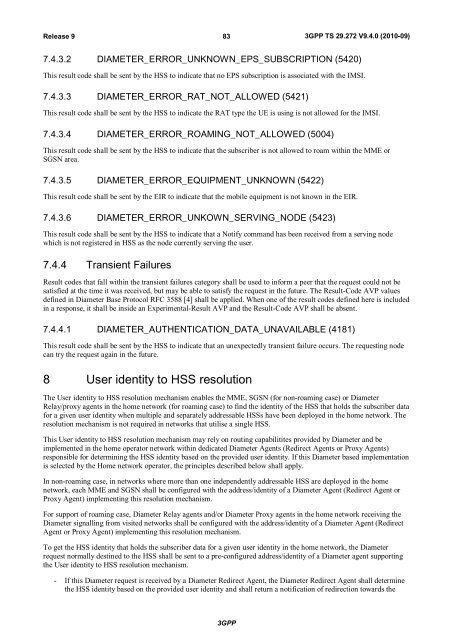The " R " Request bit — If set, the message is a request. This allows a single server to handle policies for many services. The End-to-End Identifier is an unsigned bit integer field in network byte order that is used to detect duplicate messages along with the combination of the Origin-Host AVP. The " T " Potentially re-transmitted message bit — This flag is set after a link failover procedure, to aid the removal of duplicate requests. Messages with the "E" bit set are commonly referred to as error messages. Received answers that do not match a known Hop-by-Hop Identifier are ignored by the Diameter agent.
| Uploader: | Zulkirr |
| Date Added: | 7 November 2008 |
| File Size: | 52.73 Mb |
| Operating Systems: | Windows NT/2000/XP/2003/2003/7/8/10 MacOS 10/X |
| Downloads: | 98057 |
| Price: | Free* [*Free Regsitration Required] |
The Diameter protocol was initially developed by Pat R. It is set when resending requests not yet acknowledged as an indication of a possible duplicate due to a link failure. This page was last edited on 18 Septemberat Additionally, application specific state machines can be introduced either later or at a higher abstraction layer.
In case of redirecting agents, the Hop-by-Hop Identifier is maintained in the header as the Diameter agent responds with an answer message.
Obsolete RFCs are indicated with strikethrough text.
The RFC defines an authorization and an accounting state machine. The Hop-by-Hop Identifier is an unsigned bit integer field in network byte order that is used to match the requests with their answers as the same value in the request is used in the response. The Message Length field indicates the length of the Diameter message in bytes, including the header fields and the padded AVPs.
Diameter (protocol) - Wikipedia
If cleared, the message MUST be locally processed. When creating a request, the End-to-End Identifier is set to a locally unique value.
The RFC defines a core state machine for maintaining connections between peers and processing messages. Messages with the "E" bit set are commonly referred to as error messages. It belongs to the application layer protocols in the internet protocol suite. Internet Standards Application layer protocols Computer access control protocols Authentication protocols. The End-to-End 29.227 is an unsigned bit integer field in network byte order that is used to detect duplicate messages along 292.72 the combination of the Origin-Host AVP.
Some common Diameter commands defined in the protocol base and applications are:.
headsbolomi.tk
This section needs expansion. The " R 29.272 Request bit — If set, the message is a request. Application-ID is used to identify for which Diameter application the message is applicable. Retrieved 30 April The End-to-End Identifier is not modified by Diameter agents of any kind, and the same value in the corresponding request is used in the answer.
Diameter (protocol)
The Diameter protocol requires that relaying and proxying agents maintain transaction state, which is used for failover purposes. Adding a new optional AVP does not require a new application. The " E " Error bit — If set, the message contains a protocol error, and the message will not conform to the CCF described for this command.
The values are for permanent, standard 29.272 allocated by IANA. If an AVP with the " M " bit set is received by a Diameter client, server, proxy, or translation agent and either the AVP or its value is unrecognized, the message must be rejected. This is part of the basic protocol functionality and all stacks should support it and as such 92.272 from the connectivity related operations. Diameter Applications can extend the base protocol by adding new commands, attributes, or both.
The name is a play on words, derived from the RADIUS protocol, which is the predecessor a diameter is twice the radius.
Major Shippers Country: ITALY
The Diameter protocol defines a policy protocol used by clients to perform policy, AAA, and resource control. Diameter Relay and redirect agents must not reject messages with unrecognized AVPs. Received answers that do not match a known Hop-by-Hop Identifier are ignored by the Diameter agent.

Views Read Edit View history. From Wikipedia, the free encyclopedia. If cleared, the message is an answer.

This allows a single server to handle policies for many services.

No comments:
Post a Comment